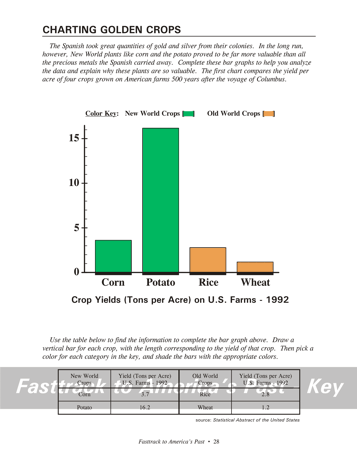| Fasttrack
to America's Past Teacher Key |
|
| Fasttrack
to America's Past Teacher Key |
|
 Page 28  Page 29 |
Pages 28
& 29 - Charting Golden Crops Making the charts Both of these are
bar graphs, and students will need two
contrasting color pencils to complete them.
Remind students to add the colors in the color key, and to use the same
color scheme for the graphs on both
pages. Review with students that the chart titles
go with the numbers on the vertical axis. The horizontal axis is
labeled with the names of the various food crops. Be sure they
understand, for example, that the number 5 on the first graph
represents a crop yield of 5 tons per acre on U.S. farms in 1992.
A ton is 2,000 pounds. It's OK to show
students a quick preview of what the finished graphs should look
like - make a drawing on the board or project this page on a
screen. But insist that students make their graphs using the data
in the table,
marking the top of the bars carefully based on the numbers, and then
drawing the bars neatly. What the chart shows, page 28 This graph shows the enormous yield of two important New World crops, corn and the potato, compared to two Old World crops, rice and wheat. The date, 1992, is 500 years after the first voyage of Columbus. A ton is 2,000 pounds. Corn and potatoes help feed the world today, and have had a big impact on history as well. They helped boost the food available to Europeans and Africans after the Age of Discovery. Ireland's history is, of course, closely tied to the potato crop and its failure in the 19th century. When the potato blight (a fungus) destroyed the crop there in the 1840s, hundreds of thousands of Irish people immigrated to the United States.
What the chart shows, page 29 This graph shows the dollar value of the same four crops listed on the previous page. Remind students that a billion is a thousand million. Show the figure for corn on the board: $19,700,000,000. Corn is especially important and valuable to American farmers because it grows well and has many uses. The crop is used in such familiar products as corn flakes and other cereals, but is also valuable for animal feed and other purposes.Background for the chart question, page 29 Corn is a very high-yield crop, as the first graph shows. It is also very nutritious, and can be used in a wide variety of ways. It can be boiled and eaten right on the cob, or the kernels can be ground into flour for use in breakfast cereal or tortilla shells. Popcorn is a popular snack, of course. Corn is also
widely used as animal feed, and even for use
in making a kind of alcohol added to gasoline. Indians called corn maize, and played a key role in developing the plant into a food crop. Over the many centuries after they first planted and harvested corn, Indians would have saved seed from plants with the largest largest ears. As this yearly pattern continued over countless generations, better and better varieties of the plant were grown. The process of selection for better varieties has continued on American farms. For example, corn as it was grown in the 1600s and 1700s was not sweet like the varieties that have been developed since. Today, the sweet varieties are a regular feature of summer cookouts and picnics. |
|
Copyright Notice
Copyright 2018 by David Burns. All rights reserved. Illustrations and reading selections appearing in this work are taken from sources in the public domain and from private collections used by permission. Sources include: the Dover Pictorial Archive, the Library of Congress, The National Archives, The Hart Publishing Co., Corel Corporation and its licensors, Nova Development Corporation and its licensors, and others. Maps were created or adapted by the author using reference maps from the United States Geological Survey and Cartesia Software. Please see the home page for this title for more information. |